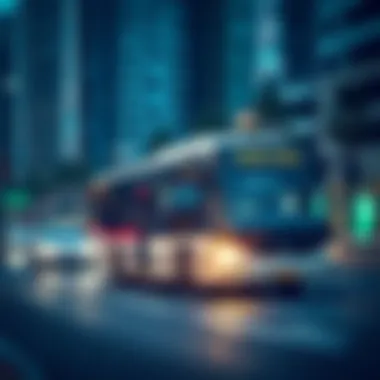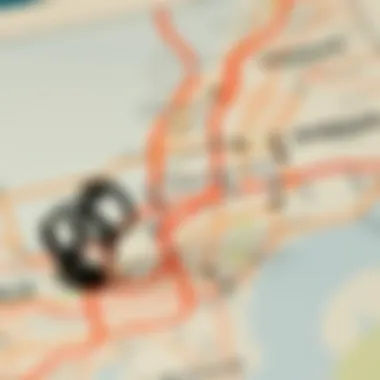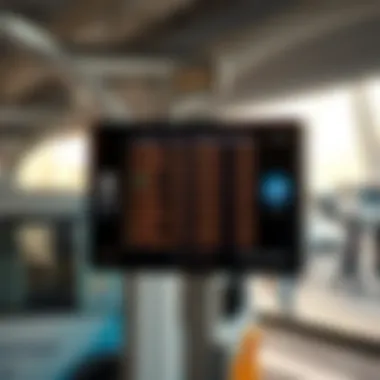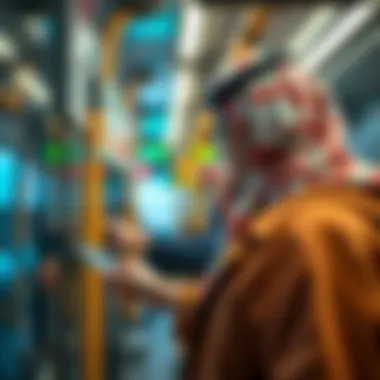Comprehensive Guide to Dubai's Bus Routes and Services


Intro
Navigating Dubai is like stepping into a modern marvel, adorned with towering skyscrapers and a vibrant culture. The bus system plays a crucial role in this intricate tapestry of urban movement. As one of the most prominent forms of public transport in the city, Dubai's buses connect various neighborhoods, commercial centers, and tourist destinations, making it essential for both residents and visitors to grasp the nuances of this system.
Understanding how to traverse the city via bus can save time, reduce travel costs, and provide a unique perspective of Dubai's diverse landscapes. In the following sections, we will plunge into the myriad of bus routes that zigzag across the city, laying down the foundation for easier navigation. This guide serves as a comprehensive resource, covering everything from route details to essential fare structures. By the time you finish this guide, you'll have all the tools at your fingertips to sail through Dubai with ease.
Market Trends and Analysis
Current Market Conditions
Dubai's bus network is not static; it is continually evolving to meet the demands of an ever-growing population. The public transportation sector is undergoing substantial transformation, with innovations aimed at enhancing efficiency and user experience. The Roads and Transport Authority (RTA) has been spearheading initiatives like fleet upgrades and real-time tracking systems. This evolution reflects a broader trend of integrating technology into transportation systems across global cities.
Currently, the bus system accommodates not only daily commuters but also tourists, significantly bolstering its importance in Dubai's economy. The system is designed to be user-friendly, offering services in multiple languages to cater to its diverse user base.
Future Predictions and Growth Areas
Looking ahead, there are several growth areas that show promise within the bus network. One noteworthy prediction involves the expansion of electric buses, aligned with Dubai's vision for sustainability. This shift could attract environmentally-conscious commuters who seek alternatives to private vehicle use.
Another area for growth is the potential increase in routes that link major landmarks and expatriate communities. As the city continues to thrive, ensuring that public transport reaches all neighborhoods will be pivotal to maintaining its status as a global hub.
Moreover, the incorporation of smart technology and mobile applications into the travel experience is set to revolutionize how residents and tourists interact with the bus system. Features like interactive route maps and automatic fare calculations can lead to greater user satisfaction and efficiency.
In summary, the bus network is poised for growth, embracing modern developments that enhance accessibility and sustainability. As Dubai advances towards becoming one of the world's leading metropolitan centers, understanding its transportation dynamics will be paramount for all who navigate its roads.
Prologue to Dubai's Public Transportation
Navigating the vibrant city of Dubai can be a daunting task, especially for newcomers. The city's public transportation system plays a pivotal role in facilitating mobility and ensuring ease of access for residents and tourists alike. As the crown jewel of urban infrastructure, public transport encompasses a range of services, including the Metro, water taxis, and, notably, the bus routes that connect various parts of the metropolis.
Overview of Public Transport in Dubai
Dubai's public transport system has evolved significantly over the years, powered by the emirate's booming population and burgeoning tourism industry. In a place where skyscrapers reach for the heavens, bus routes weave through the cityscape, creating a robust network that complements other modes of transport. The Roads and Transport Authority (RTA) manages these services, ensuring a high standard of efficiency and convenience.
From the ultra-modern Metro trains that glide silently through the streets to ambient buses echoing the hustle of daily life, every mode serves a unique purpose. With a focus on sustainability, the transit system is continuously upgrading. The introduction of key facilities — such as air-conditioned bus stops and accessible transport options — is evidence of the forward-thinking approach taken towards urban mobility.
Importance of Bus Routes
Bus routes hold a prominent position in Dubai's transport framework. They are not merely channels for commuters but are critical in bridging gaps where other transport modes may falter.
- Accessibility: Buses extend their reach beyond the limited areas of the Metro, connecting various public hotspots - schools, malls, and business districts. This makes them an essential part of the everyday travel routine of many residents and visitors.
- Cost-Effectiveness: With affordable fare structures, buses serve as a practical option for those looking to navigate the city without breaking the bank. This is particularly beneficial for workers commuting daily, making them a staple for the workforce.
- Environmental Considerations: As cities worldwide strive for greener options, Dubai is also taking strides in this direction. By promoting bus usage, the RTA reduces the volume of individual vehicles on the roads, contributing positively to air quality and sustainability goals.
In summary, understanding the intricacies of public transport, particularly the bus routes, is essential for anyone aiming to seamlessly navigate through Dubai. These routes embody the spirit of connectivity and accessibility, making them indispensable in the urban tapestry that is Dubai.
Structure of the Dubai Bus Network
The efficiency of public transportation greatly hinges on its structure, especially in a bustling metropolis like Dubai. Understanding the structure of the Dubai bus network is vital for residents, investors, expatriates, and anyone seeking to navigate the city's vibrant urban fabric. A well-structured bus network not only facilitates accessibility but also fosters economic growth and enhances the overall quality of urban living. In this section, we'll explore the essential components of the bus system and the nuanced route classification.
Key Components of the Bus System
Dubai's bus system is a complex yet well-integrated part of the city’s overall transport infrastructure. Here are some key components that define its effectiveness:
- Bus Fleet: The fleet comprises a diverse range of buses, from standard buses to articulated ones, catering to varying passenger needs. This diversity ensures capacity management based on different routes and peak times.
- Bus Stops: Strategically placed throughout the city, bus stops are designed to be user-friendly. Many stops are equipped with digital displays that show real-time arrival information—a feature that reduces the uncertainty of waiting times.
- Terminals: Major terminals such as Al Ghubaiba and Rashidiya serve as central hubs where passengers can switch between different bus routes, creating a seamless travel experience. These terminals often include amenities like waiting lounges and ticketing services.
- Accessibility Features: With a growing emphasis on inclusivity, Dubai's buses are equipped with ramps and designated seating to accommodate passengers with disabilities. This approach ensures that everyone can access the public transport system easily.
The integration of these components provides a robust structure that supports the smooth functioning of bus transport in Dubai. Moreover, it enhances the overall commuting experience for a diverse population.
Route Classification
Route classification in Dubai's bus network is an essential framework that categorizes routes based on their purpose, frequency, and coverage. Understanding this classification can aid users in choosing the right bus service for their needs. Here’s how routes are generally classified:
- Local Routes: These routes connect smaller sub-areas within neighborhoods. They are essential for residents to access local amenities, making them crucial for daily commutes.
- Express Routes: Designed for faster travel between major points without frequent stops, express routes help commuters reach their destinations quickly. They serve key hubs and commercial districts, greatly benefiting business professionals and tourists alike.
- Feeder Routes: These routes act as connectors between major transit points, such as metro stations and residential areas. They play a strategic role in integrating different modes of public transportation, allowing for easier transfers.
- Night Services: Recognizing the need for late-night connectivity, some bus routes operate during the night. This service is particularly valuable for shift workers and night owls.
By categorizing routes effectively, Dubai can ensure that its bus network meets varying passenger demands, optimizing travel across the city.
A well-structured bus system not only aids in meeting daily travel demands but also contributes to a more sustainable urban environment by reducing traffic congestion and pollution.
Understanding the structure of the bus network in Dubai provides valuable insights into the inner workings of the public transport system, equipping users with knowledge to navigate more efficiently and effectively.
Detailed Analysis of Major Bus Routes
Understanding the specific bus routes in Dubai is crucial, given that these routes facilitate direct access to various essential locations throughout the city. In this section, we will navigate through the intricate details of the major bus routes, observing how they interconnect with other forms of transportation and support urban mobility. Notably, the analysis of the bus routes reveals how they cater to different demographics, effectively reducing the burden on personal vehicle usage, which is often disrupted by congestion.


Route Numbering System
The route numbering system of Dubai’s bus services functions as a metaphorical map to the urban layout of the city; it is designed for simplicity and effectiveness. Bus routes are primarily categorized into three segments: local, intercity, and feeder routes.
- Local Routes: These are numbered from 1 to 99. They navigate through the main residential and commercial areas, allowing passengers quick access to neighborhoods and frequent stops.
- Intercity Routes: Ranging from 100 to 199, these routes link Dubai with other emirates, providing vital connections to places like Abu Dhabi and Sharjah.
- Feeder Routes: Identified by numbers over 200, these routes serve as connectors between major transit hubs, like metro stations and other transport systems, ensuring convenience for commuters.
This structured approach not only aids busy travelers in identifying their destination with ease but also enhances the overall efficiency of the public transit system. Knowing the numbering scheme can drastically shorten the learning curve for new commuters, making it easier to navigate through the bustling city.
High-Frequency Routes
Perhaps one of the standout features of the bus network is the implementation of high-frequency routes, which mirror the needs and habits of Dubai's residents and visitors. These routes run at shorter intervals, often every 10 to 15 minutes, effectively minimizing wait times, especially during peak hours.
The high-frequency routes tend to service densely populated areas and major attractions. Some examples include:
- Route 8: Connecting Bur Dubai with Deira, this route caters to both locals and tourists, traversing through significant shopping districts.
- Route 21: This route facilitates easy access to the Dubai Marina and Jumeirah Beach, ideal for leisure seekers.
By providing such regular service, these routes not only enhance convenience but also promote the use of public transport, countering the phenomenon of traffic congestions attributable to personal vehicle reliance.
Routes Connecting Key Areas
The fabric of Dubai's urban landscape is woven with bus routes that connect crucial zones: business hubs, educational institutions, and recreational areas. Understanding these connections gives insight into how well public transport serves the community.
- Business Areas: Routes such as 50 and 77 link financial districts, ensuring that professionals can commute without hassle. This accessibility directly contributes to productivity and economic growth.
- Educational Institutions: Many routes serve schools and universities, such as Route 88, ensuring that students can travel safely and affordably.
- Recreational Areas: Routes are intentionally laid out to connect parks, shopping malls, and entertainment centers. For instance, Route 94 gets you straight to Global Village, making it a staple for family outings.
"Public buses not only serve as modes of transport; they act as veins within the vibrant cityscape, nourishing communities by connecting them to essential services."
In summary, the analysis of major bus routes unveils their ability to alleviate congestion, enhance connectivity, and foster economic activity within Dubai. Understanding the nuances of bus route numbering, high-frequency schedules, and strategic connections to key areas illustrates the integral role these routes play in urban mobility.
Bus Schedules and Frequency
Navigating a bustling metropolis like Dubai often hinges on understanding the nuances of its public transport systems, particularly the bus service. The timings and frequency of buses play a critical role in determining how effectively one can traverse the city. A well-managed bus schedule ensures that commuters save time and can plan their journeys with confidence.
There’s a certain rhythm to the bus schedules in Dubai that caters to both residents and tourists alike. These schedules are not just operational charts; they reflect the city's pulse. Knowing when to expect the next bus can significantly reduce your waiting time, giving you more freedom to enjoy your day. Moreover, an efficient bus schedule aligns with other modes of transportation, enhancing overall connectivity. This interconnectedness is especially vital for anyone looking to engage with the city’s various attractions, neighborhoods, and business hubs.
Operational Hours
Dubai's buses generally operate from 4:00 AM to midnight, with variations dependent on specific routes. The key operational hours are crucial for anyone planning an early morning flight or a late-night outing.
- For the Early Birds: Buses starting at 4:00 AM give early risers a head start, especially those commuting to work or heading to morning appointments.
- Last Call: The last buses usually leave the major terminals around midnight. This is perfect for those winding down after a long day of exploring the city.
- Weekend Variations: On Fridays, operational times can be slightly different. Buses begin operating later in the morning, aligning with local customs and the start of weekend activities.
It's worth emphasizing that checking the latest schedules through mobile apps or the Roads and Transport Authority's (RTA) official site can save you from inconvenience.
Peak vs. Off-Peak Hours
In the context of public transport, understanding peak and off-peak hours can spell the difference between a convenient journey and a frustrating commute.
- Peak Hours: Typically, the busiest times are during the morning rush from around 7:00 AM to 9:00 AM and the evening rush from 5:00 PM to 8:00 PM. Buses during these times may be packed, making it advisable to plan your journey accordingly.
- Off-Peak Hours: Conversely, traveling during off-peak periods (mid-mornings after 9:00 AM and late evenings) offers a significantly more comfortable experience with much less crowding. It’s during these hours that one can find a seat more easily and enjoy a less chaotic trip.
In summary, being aware of these schedules enhances your mobility across Dubai, whether you're a resident heading to work or a tourist aiming to see the sights. Reasonably adjusting your travel time to align with bus schedules can provide not just convenience but also a smoother overall experience.
Fare Structure and Payment Options
Understanding the fare structure and payment options is central to utilizing Dubai's bus system efficiently. Whether you are a resident or a visitor, having a grasp of these elements enriches the experience and allows for seamless travel throughout the vibrant city. The bus system is designed with various fare zones and payment methods, making it accessible for everyone.
Understanding Fare Zones
Dubai's bus fare system is divided into specific fare zones, which directly influence the cost of your journey. Each zone encompasses a range of destinations, and the fare is determined by the number of zones you traverse during your trip. Here’s how it works:
- Zone Division: The city is categorized into multiple fare zones, each marked clearly on maps and at bus stops. Traveling within a single zone may involve a lower fare compared to traversing multiple zones.
"Knowing the zones you are entering can save you a pretty penny! Being aware of your journey's length will prevent you from paying more than required."
- Fare Calculation: The cost per trip increases with each additional zone crossed. For instance, traveling from Dubai Marina to Al Qusais may involve crossing several fare zones, resulting in a higher price.
- Sample Fare Levels:
- 1 Zone: 3 AED
- 2 Zones: 5 AED
- 3+ Zones: 7 AED or more
This method not only organizes the transport system but also provides a transparent pricing structure which can encourage users to plan their journeys more effectively.
Payment Methods Available
Dubai's transport network has embraced modern payment technology, offering a variety of convenient options for purchasing fares. The following methods are predominant in the bus system:


- NOL Card: This smart card system is the backbone of fare payments. It operates across various transport modes including buses, metro, and water taxis. Users can load credit onto their cards at designated kiosks or through mobile applications.
- Mobile Payment: Commuters can also pay via mobile apps, including the RTA app, which allows users to recharge their NOL Cards easily, check bus timings, and track routes in real time.
- Cash Payments: For those who prefer traditional methods, cash payments are accepted at the bus stations and certain stops. However, a small premium might apply when purchasing tickets directly from drivers. While it remains an option, cash payments might not be the most efficient.
To sum it up, being aware of fare zones and the variety of payment methods empowers travelers to navigate Dubai's bus network with both ease and economical efficiency. This understanding lays a foundation for a smoother and more enjoyable transportation experience in the city.
For more information on Dubai's public transport system, you can visit the RTA official website.
Technological Integration in Bus Services
In today’s fast-paced world, how a city integrates technology into its public transportation can make all the difference. In Dubai, the bus service is a testament to this trend. The incorporation of advanced technologies enhances not only efficiency but also the overall riding experience. A significant leap toward modernization means that residents and visitors can rely on these buses for seamless travel.
Real-Time Tracking Systems
Real-time tracking systems have revolutionized the way passengers interact with Dubai's bus services. Gone are the days when one would wait at a bus stop uncertain about arrival times. With the use of GPS technology, passengers can check the status of their buses from their smartphones and other devices. This system not only provides estimated arrival times but also alerts passengers of delays or unexpected changes to routes.
Benefits of Real-Time Tracking Systems:
- Increased Convenience: You no longer need to waste time waiting at the bus stop without knowing if the bus is on its way or stuck in traffic.
- Enhanced Reliability: Knowing precisely when a bus will arrive adds a layer of trust to the public transport system.
- Emergency Notifications: In situations where immediate changes happen, such as accidents or route closures, notifications can be sent to users instantly.
“The integration of real-time tracking systems serves to assure passengers while simultaneously fostering a sense of independence in travel.”
Mobile Applications for Passengers
With the rise of smartphones, mobile applications have become essential tools for navigating public transport. Various apps specific to Dubai’s bus services allow users to plan their journeys efficiently. These apps not only inform riders of routes and schedules but also guide them through the most efficient paths considering traffic patterns, time of day, and bus frequencies.
Key Features of Mobile Applications for Passengers:
- Journey Planner: Users can input their destination to receive tailored routes and estimated travel time.
- Bus Schedule Information: Live updates regarding bus schedules mean riders can make real-time decisions about their travel plans.
- User-Friendly Interface: These apps are designed for ease of use, ensuring that even those unfamiliar with technology can effectively navigate them.
The right technological integration thus empowers every individual relying on the bus system, making travel through Dubai not just easier but smarter.
Accessibility Features on Dubai Buses
Accessibility features on Dubai buses play a significant role in ensuring that public transportation is inclusive for all individuals, particularly those with disabilities. This commitment to accessibility reflects Dubai's dedication to creating a welcoming environment, enabling everyone to navigate the city with ease. To be effective, the bus system incorporates several specific elements that cater to a diverse range of needs.
Facilities for Disabled Passengers
Dubai's buses are equipped with various facilities designed specifically for disabled passengers. For starters, many buses feature low-floor designs which make entry and exit easier for people using wheelchairs or those who have limited mobility. These low floors minimize the steepness of the entrance, eliminating the need for steps, which can pose a barrier for many.
Moreover, each bus comes with designated seating areas that are clearly marked for individuals with disabilities. This ensures that these passengers have a safe spot during their journey. In addition, bus operators are trained to offer assistance when necessary. They are often more than willing to help passengers onboard or offboard if needed.
Furthermore, visual and auditory announcements are important aspects of accessibility. Each bus is fitted with systems that announce stops and provide crucial information. This aids passengers who may have visual impairments, ensuring they can travel confidently and independently.
Accommodations for Families and Elderly
In addition to addressing the needs of disabled passengers, Dubai's buses also take into account families and the elderly. Spacious interior designs allow families with strollers to navigate comfortably. This is vital for parents traveling with young children, making it straightforward for them to board and secure their strollers during the journey.
The buses have wide aisles and ample space, allowing for easier movement inside the vehicle. This is especially beneficial for elderly passengers, who may need to walk slowly or utilize mobility aids. It’s not uncommon to see priority seating available for seniors, ensuring they have ease of access to a comfortable spot while traveling.
In terms of safety, the buses are equipped with handrails and grip handles, making it easier for everyone to stabilize themselves while the bus is in motion. The overall emphasis on safety and accessibility guarantees that families and older adults can navigate the city's public transport system without unnecessary stress.
The Dubai bus system continuously evolves to address the diverse needs of its passengers, both young and old, ensuring that everyone can travel with confidence and comfort.
To further support these initiatives, the Roads and Transport Authority (RTA) continually seeks feedback from the community, seeking ways to enhance accessibility and improve the experience for all bus users. The features outlined illustrate a clear dedication to maintaining a transportation system that is not just efficient, but also inclusive.
Bus Stops and Stations
Bus stops and stations form the backbone of the bus transportation network in Dubai, serving as vital points where passengers can board, alight, and often transfer between routes. The well-thought-out placement and design of these stops enhance the overall accessibility and functionality of the public transportation system, making it essential for residents and visitors to understand their significance.
Design and Features of Bus Stops
Dubai's bus stops are designed with passenger convenience in mind. Each stop typically features the following elements:
- Shelters: To protect passengers from the sun or rain, most bus stops have shelters that provide shade.
- Seating: Many stops have seating areas, allowing passengers to wait comfortably for their bus.
- Information Displays: Electronic boards often display real-time bus arrival information, helping passengers plan their journeys effectively.
- Schedule Timings: Each bus stop displays route information and a schedule, giving clear details on bus timings and connections.
- Accessibility Features: Most stops are equipped with ramps and tactile guidance paths for visually impaired individuals, ensuring that everyone can use the service.
These features not only make the experience pleasant but also promote the use of public transport, thereby reducing traffic congestion in the city.
Major Bus Terminals
Major bus terminals in Dubai are interconnected hubs that facilitate easy transfers to various bus routes and sometimes link to other transportation systems like the Metro. Notable terminal points include:


- Al Ghubaiba Bus Station: One of the busiest terminals, this station serves numerous local and inter-city routes, providing a crucial link for commuters and travelers alike.
- Dubai Marina Bus Station: This terminal caters specifically to the vibrant area of Dubai Marina, allowing tourists and residents easy access to the attractions.
- Union Square Bus Station: Located centrally, it offers comprehensive connections to various bus routes, making it a key intermodal hub.
These terminals are meticulously designed to handle a significant volume of passengers while ensuring efficient operations. They provide facilities such as waiting areas, restrooms, and food vendors, creating a comprehensive travel experience.
Efficient bus stops and terminals are not just about getting from A to B; they enhance the journey itself, instilling in passengers a sense of comfort and confidence as they navigate the bustling city.
Understanding the design and function of bus stops and terminals in Dubai helps both residents and newcomers appreciate the city's commitment to public transport. Clear, accessible, and strategically located stops contribute actively toward not only improving public transit experiences but also encouraging more sustainable travel habits.
Future Developments in Dubai Bus Services
As Dubai constantly evolves, the bus service stands as a crucial lynchpin in urban transport. With the city transitioning to more dynamic forms of transportation, it becomes imperative to not only recognize but also anticipate the forthcoming developments in the bus network. In this era of rapid change, understanding these developments is vital for residents, investors, and visitors alike. The enhancements in the bus system aim to not merely keep up with existing demands but to foster an even more efficient, user-friendly experience.
Expansion Plans for Routes
Dubai's ambition in transportation clearly shines through its various expansion plans for bus routes. Considered by many experts as a key improvement area, the goal is to create a wider network connecting all major residential and commercial hubs.
- New Routes: With the city's ever-expanding borders, newly proposed routes will facilitate access to emerging neighborhoods and development projects. This includes areas such as Dubai South and Dubai Marina.
- Increased Coverage: An enhanced bus network will ensure that even the far reaches of Dubai are linked, thereby making public transport options more accessible. The strategy centers on reaching a broader demographic, ensuring that no district remains isolated.
- Integration with Other Transport Modes: The expansion will also align with metro lines and tram services, fostering seamless transitions for users moving between different modes of transport.
Overall, these developments aim to ease congestion on roads while promoting the use of public transport, which is more sustainable and environmentally friendly.
Sustainability Initiatives
Sustainability is not just a catchphrase in today’s world; it influences how cities are shaping their transport systems. Dubai is no exception, as the bus service embraces several sustainability initiatives to reduce its carbon footprint and comply with global environmental standards.
- Eco-Friendly Buses: Investment in electric and hybrid buses is at the forefront. These vehicles are designed to minimize emissions, making the entire fleet more environmentally friendly.
- Solar-Powered Bus Stations: Future bus stops will feature solar panels, harnessing renewable energy to power the facilities, which will cut down on electricity costs and use cleaner energy sources.
- Waste Reduction Programs: In conjunction with the bus network, Dubai plans to implement waste management measures at bus depots and stations, promoting recycling and responsible disposal of materials used in operations.
"The shift toward sustainable public transportation is not just necessary; it's the hopeful direction we should embrace for future urban planning," stated an urban development expert.
Engaging in these sustainability initiatives aligns Dubai’s public transport policies with global trends and helps set a standard for other cities to follow.
Through these future developments in bus services, passengers and investors alike are presented with an evolving system that promises to be both efficient and environmentally responsible.
Challenges Facing the Bus System
The bus system in Dubai, while vigorously developed and expanding, faces a few hurdles that could affect its overall efficacy. Addressing these issues is paramount for maintaining not just the transportation network’s functionality but also fostering a dependable public image that residents and visitors can trust. If the bus services don’t operate smoothly, the entire public transport system can suffer. This section explores the significant challenges, providing insights into how they impact the overall user experience.
Traffic Congestion Issues
Traffic congestion is like the ever-looming shadow that hangs over many urban centers, and Dubai is no exception. The city’s rapid population growth and constant influx of tourists exacerbate this problem. In rush hours, bus routes can become ensnared in the same gridlock that plagues private vehicles.
When buses are stuck in traffic, it not only impacts timeliness but also frustrates passengers who rely on them for their daily commutes. It’s crucial for transport planners to recognise that a large percentage of bus routes overlap with busy streets. This creates bottlenecks that can delay service and diminish the appeal of using the bus. To mitigate such issues, smart traffic management solutions, such as synchronized signals for buses at intersections, can be explored.
- Utilising dedicated bus lanes could alleviate this congestion noticeably.
- Real-time traffic data can assist in adapting bus routes dynamically.
These measures, if implemented effectively, could lead to enhanced travel experiences for the daily rider and improve the overall efficiency of the public transport network.
Maintaining Efficiency and Reliability
To ensure that the bus system remains a cornerstone of public transport, it must be consistently efficient and reliable. An unreliable bus schedule can tarnish the reputation of the service, deterring people from opting for buses as a mode of transportation. This reliability is influenced by various factors, including vehicle maintenance, driver training, and adherence to schedules.
Buses that frequently break down or deviate from scheduled routes can result in passengers feeling disenchanted, pushing them towards using private vehicles or other forms of transport.
- Regular servicing of buses should be standard practice to maintain their mechanical health.
- Driver training programs must include efficiency tactics, ensuring that all drivers are not only familiar with traffic laws but also effective in managing their time on the road.
Furthermore, transparency regarding bus schedules, such as providing updates through mobile applications, assists passengers in planning their journeys effectively. A transparent communication strategy enhances users' trust in the system, vital for its long-term success.
"Effective public transportation signifies the heart of urban mobility—if it falters, the entire city feels the tremors."
In summary, tackling traffic congestion and ensuring reliability stand as dual pillars essential for the success of Dubai's bus services. To champion a robust public transport system, ongoing attention to infrastructure improvements, technology adoption, and effective planning is necessary.
The End
The conclusion of this comprehensive exploration of Dubai's bus routes serves as a crucial touchstone for understanding not just the logistics of transportation in the city, but also its broader impact on urban living. It highlights key components about the bus system that distinctly contribute to the vibrancy of daily life for both residents and tourists in Dubai.
Summary of Key Points
In summary, several critical aspects have come to light about Dubai's bus system:
- Widespread Connectivity: The bus routes offer extensive coverage throughout wide areas, making it cheaper and quicker for commuters to travel.
- Accessibility and Inclusivity: Resources like wheelchair access and provisions for families ensure that bus travel is an option available for many.
- Technological Integration: Real-time tracking and mobile apps modernize the user experience, enhancing efficiency and satisfaction among passengers.
- Fare Structure: A well-defined fare system allows for flexible payment options, aiding both everyday commuters and occasional travelers.
These points express essentials of the bus network in Dubai, garnering attention for their role in easing movement throughout the city, thus underscoring their importance.
The Role of Bus Routes in Urban Mobility
Bus routes in Dubai play a pivotal role in the city's urban mobility by bridging gaps between residential, commercial, and leisure areas. With a surge in urban population and tourism, effective public transportation emerges as a fundamental element for sustainability and efficiency.
- Influence on Urban Design: Well-planned bus routes encourage zoning that fosters vibrant neighborhoods. In areas with readily accessible bus stops, property values tend to rise due to increased foot traffic, convenience, and accessibility.
- Reducing Traffic Congestion: By providing an alternative to personal vehicle use, bus systems contribute significantly to reducing traffic jams. Less reliance on cars effectively diminishes the congestion that degrades urban environments.
- Environmental Benefits: An efficient bus system can lead to fewer carbon emissions per capita, making it a greener transportation choice. The lower environmental footprint aligns with global sustainability goals, making urban spaces in Dubai more livable.
- Social Equity: Public transport primarily benefits lower-income groups who may find it challenging to maintain a personal vehicle. This inclusivity fosters a sense of community and connectivity amongst various demographics.











